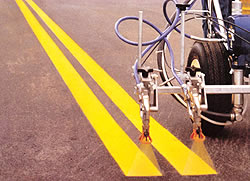
…continued from previous page
Parking Lot Striping, Traffic Paint
The Business of Striping - traffic stripping, painting traffic lines, parking lot painting
by Stacey Klemenc
, owner of Superior Striping Inc. in Ramsey, Minn., and Craig Jameson, owner of Bergman Cos. Inc. in Eau Claire, Wis., have each been in the line painting business for about 20 years.
Both men’s businesses center mainly on striping parking lots. In fact, Fredrickson notes, his company paints 1,800 to 1,900 parking lots a year in the Minneapolis-St. Paul area.
Besides striping and restriping parking lots of all sizes, Jameson’s company also lays down seal coatings and works with some municipalities and local airports.
It only made sense to offer seal coating as one of his company’s services, Jameson explains, since a lot needs to be painted after it’s coated. And every couple of years, that same lot needs to be repainted. “We provide a full service in the line paint market,” he says.
 Jameson says his municipal customers came on board after he approached struggling crews trying to use rollers to paint the streets of small towns. “We showed them that we could come in and in a few nights the job would be done. No fuss; no muss.” Jameson says his municipal customers came on board after he approached struggling crews trying to use rollers to paint the streets of small towns. “We showed them that we could come in and in a few nights the job would be done. No fuss; no muss.”
Frederickson says his company works on small roads here and there but “the insurance guy doesn’t like us working on roads. We don’t have the warning signs and all those other things you need.”
Jameson says his company primarily uses waterborne paint — “with that use increasing because of environmental concerns” — but he still mainly uses chlorinated rubber for parking lots. “It’s a high-performance paint that shows up well and produces quality lines.”
Frederickson estimates that his company uses chlorinated rubber or chlorinated polyolefin — “Some call it modified alkyd” — on 95 percent of their jobs because the paint dries so fast. The remaining 5 percent involve an alkyd or latex paint.
Determining what type of paint to put down “also depends on the specifications of the parking lot and the type of seal coat present. You have to use the right products for the right situation,” says Jameson.
For instance, Frederickson says, if you’re painting over a water-based black liquid seal coat, also known as coal tar, you must use latex. “If you use an alkyd or chlorinated rubber, the white paint will turn green and the yellow paint will turn brown.”
But latex, although it can be used over anything, isn’t his choice to stripe parking lots, which are typically painted at night. “We use chlorinated rubber. It dries in 30 seconds and we don’t even have to put cones out. It dries real nice at night. If we had to go to latex, our season would be shortened a lot.”
If you’re thinking of starting your own business, Fredrickson says you’ll need a pickup and trailer, a walk-behind striping machine, stencils and cones, a 300-foot tape measure and some type of chalk line or string line. It’s also nice to have a blower if the sweeper doesn’t do an adequate job, he adds.
“You could probably get by with [investing] $5,000 if you buy used equipment,” he says. “I spent $10,000 to start up.”
Jameson prefers airless applicators for parking lots because they produce crisper lines. And if you’re looking at striping malls or other large parking lots, he notes, you should invest in a driver, a machine that attaches to a walk behind. “This way you can sit down and motor around the parking lot. It really increases efficiency and takes a lot of the physical work out of striping.” Not to mention, you can easily haul around a 15-gallon bucket rather than a five. A driver costs about $3,500.
Besides the proper equipment, insurance and a skilled operator, you need a working knowledge of federal, state and local regulations. And you need to know if there is an established price structure in your area so that your bids can be competitive. “You have to know the market and you need to educate your customers so that they see the value of painting the parking lot every year. You have to make them understand why it’s important.”
 Above all, you need to know the goals of the parking lot owner. What does he hope to accomplish with the paint job? “Line painting controls traffic and gets people and vehicles through the property. It can provide good direction, identify hazards and safe zones and restrict access. It can provide special accommodations for people with special needs and it can promote a positive perception of the establishment prior to people entering it. It can help prevent insurance liability problems. Different customers have different needs. Once you’ve identified their particular needs and areas of importance, you can get that done and get that done well.” Above all, you need to know the goals of the parking lot owner. What does he hope to accomplish with the paint job? “Line painting controls traffic and gets people and vehicles through the property. It can provide good direction, identify hazards and safe zones and restrict access. It can provide special accommodations for people with special needs and it can promote a positive perception of the establishment prior to people entering it. It can help prevent insurance liability problems. Different customers have different needs. Once you’ve identified their particular needs and areas of importance, you can get that done and get that done well.”
|

